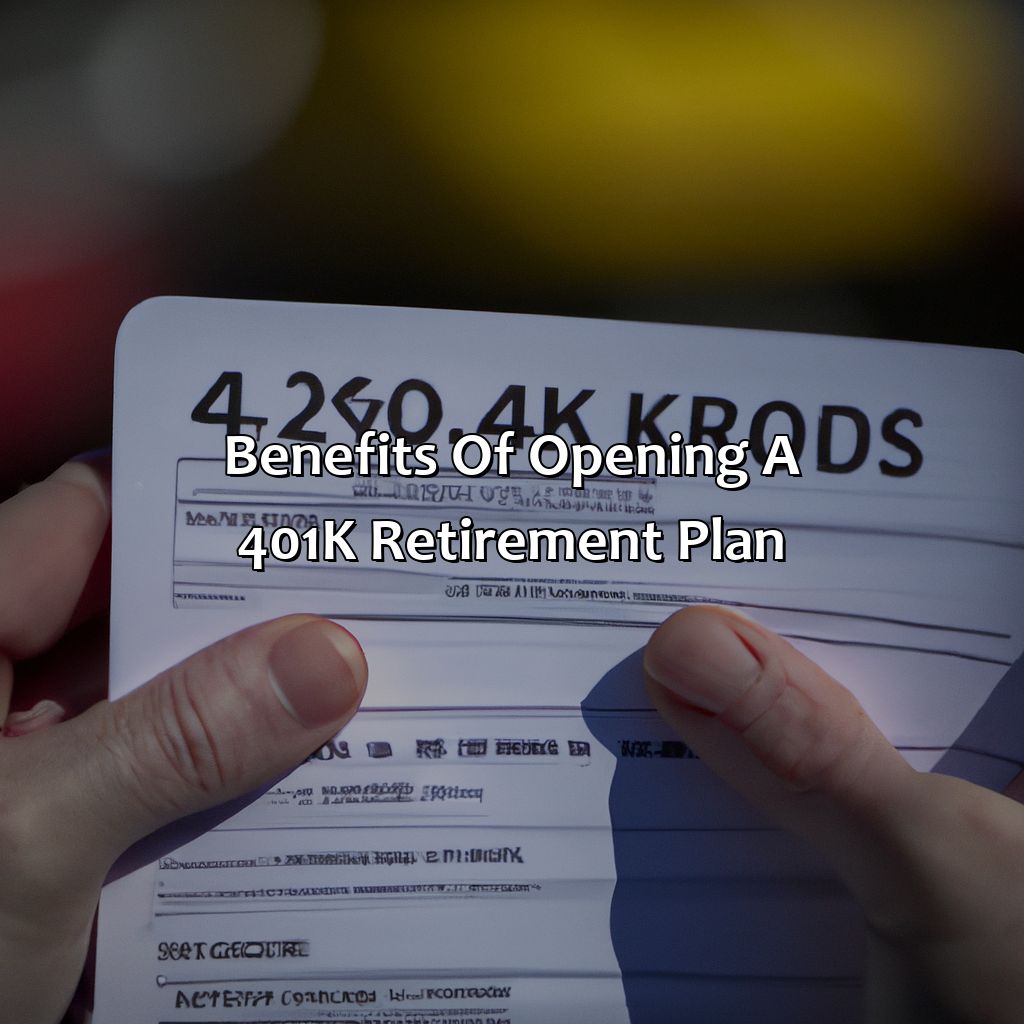How To Open A 401 K Retirement Plan?
Key Takeaway:
- Opening a 401k retirement plan provides long-term financial security: A 401k plan is an excellent way to save for retirement, allowing individuals to accumulate wealth over time and reducing the risk of financial insecurity in the future.
- Setting up a 401k plan is simple and straightforward: Eligibility criteria, choosing a plan provider, selecting investment options, and setting up contribution options are the critical steps in setting up your 401k plan. It is essential to understand these steps and the options available to make the right decisions for your retirement savings.
- Managing your 401k plan is crucial for maximizing returns and minimizing taxes: Regularly checking and adjusting your investment portfolio, maximizing your contributions, and understanding taxes and penalties are critical for ensuring that you are getting the most out of your 401k retirement plan.
Are you looking for the best way to save for retirement? Opening a 401k plan can help you reach your financial goals and secure your future. You will learn the details of how to open a 401k and the advantages of this retirement account.
Benefits of opening a 401k retirement plan
Opening a 401k retirement plan can provide significant benefits for individuals seeking financial security in retirement. By investing in a 401k, employees can contribute pre-tax dollars to their retirement savings which can grow tax-free until they withdraw the funds. This not only provides a tax break but also allows for compound interest to work its magic.
- 401k plans offer tax benefits
- Employee contributions are matched by employers in some cases
- 401k plans help individuals make disciplined savings a habit
- Investment options within 401k plans offer diversification
It’s important to note that contributing to a 401k plan can also decrease an individual’s taxable income, which can lead to a lower tax bill come April. In addition to the tax advantages and potential for compound interest, 401k plans are considered one of the most popular and effective ways to save for retirement.
It’s recommended that individuals contribute as much as possible to a 401k plan, especially if their employer provides any matching contributions. Additionally, it’s important to create a well-diversified portfolio using the investment options available within the plan. By consistently contributing and monitoring the investments, individuals can ensure a comfortable retirement.

Image credits: retiregenz.com by Harry Duncun
Steps to open a 401k retirement plan
- Check your eligibility to open a 401k retirement plan.
- Select a plan provider for your 401k.
- Pick the right investment options for your retirement plan.
- Decide your contribution options for the 401k.
- Designate the beneficiaries who will inherit your 401k!

Image credits: retiregenz.com by Adam Woodhock
Eligibility criteria for opening a 401k retirement plan
To determine qualifications for starting a 401k retirement plan, an individual must meet certain criteria. These criteria are based on various factors such as their age, employer, and income level.
- Age: To open a 401k plan, one must be at least 18 years old.
- Employment Status: An individual must be employed by a company that offers a 401k retirement plan to its employees.
- Income Level: There may be minimum income requirements set by the employer in order to qualify for their particular 401k plan.
- Citizenship Status: In most cases, only US citizens, US residents or Green Card holders are eligible for the plan.
It is important to note that each employer may have different eligibility requirements for their particular 401k retirement plan. Therefore, it is advisable to consult with the human resources department of one’s company to determine specific requirements.
Individuals can also participate in traditional IRAs even if they have a 401k. It is worth considering both options depending on one’s unique financial circumstances and plans for retirement.
To ensure an easy opening process for a 401k retirement plan, individuals should prepare necessary documents beforehand including identification documents, employment details, and financial information. It is also recommended to seek advice from a financial advisor or investment professional to make informed decisions about contributions and investments within the plan.
Choosing a plan provider is like choosing a life partner – pick the wrong one and you’ll be stuck with them for years, regretting every decision you’ve made.
Choosing a plan provider
When it comes to selecting a provider for your retirement plan, the process can seem overwhelming. Here are three key things to consider:
- Cost: Look for a provider who offers competitive fees and doesn’t charge excessive expenses.
- Investment options: Ensure the provider has investment choices that align with your goals and values.
- Service: Choose a provider with reputable customer service, who can assist with your questions or concerns.
It’s important to note that different providers offer varying levels of flexibility and support. Therefore, carefully research each provider before making a decision.
When considering providers for your retirement plan, it may also be helpful to explore their track record for investment growth over time. This information can provide insight into the potential success of your future investments.
A colleague of mine once chose a plan provider solely based on the advice of a friend, without doing any additional research. Unfortunately, she later found out that her chosen provider had limited investment options and was charging higher fees than other available options. Lesson learned – always do your own research before making important financial decisions!
Because who needs a stable financial future when you can just put all your retirement savings on red or black?
Selecting investment options
When it comes to planning for retirement, choosing the right investment options is crucial. With a 401k retirement plan, investors have several investment options to choose from, including stocks, bonds, and mutual funds. It’s important to consider factors such as risk tolerance, investment goals, and time horizon when making these decisions. Additionally, diversification can help spread risk across different asset classes.
To make the selection process easier, many plans offer target-date funds that automatically adjust asset allocation as an investor approaches retirement. Investors should review their investment choices periodically and consider seeking professional advice if needed.
A friend of mine had invested heavily in one particular stock through his 401k plan without diversifying his portfolio. When the company experienced financial troubles, his retirement savings took a serious hit. He learned the hard way about the importance of diversification and regular monitoring of investments.
Make it rain (savings) with your 401k contribution options, but don’t forget to bring an umbrella for those rainy days.
Setting up contribution options
When it comes to taking advantage of a 401k retirement plan, setting up contribution options is an essential step. This involves choosing how much and how often you want to contribute to your retirement account.
Here is a 6-Step Guide to “Customizing Contribution Terms” in the right way:
- Start by determining the amount you can afford to contribute each paycheck; this should be at least enough to receive your employer’s matching contribution if it’s offered.
- Select either a percentage of your income or a fixed dollar amount that will automatically transfer from each paycheck into your 401k account.
- Choose whether you want contributions made before taxes (pre-tax) or after taxes (Roth). Pre-tax may reduce your taxable income, while Roth contributions are tax-free upon withdrawal.
- If offered by your employer, consider an automatic enrollment feature. Rather than opting in, employees are enrolled as soon as they’re eligible unless they opt out.
- Decide whether you want contributions automatically escalated over time. You might start with a smaller contribution now and increase it annually until you reach your desired amount.
- Make sure to review and adjust your contribution settings annually or when significant life changes occur.
It’s important to note that many employers offer additional contribution options beyond these basics, such as paying bonuses directly into your 401k account or offering catch-up contributions if you’re over age 50.
Customizing contribution terms can take some time, but it’s time well spent since these decisions can significantly impact the size of your retirement fund. Making informed choices will pay off not only throughout your employment days but also during your years of retirement.
One individual we know did not set up their 401k plan until later in their career because they did not understand the importance of saving for retirement early. As a result, they had fewer funds than they could have had otherwise. By educating themselves and maximizing their 401k contributions, they were able to build a substantial nest egg once they truly understood the importance of saving towards retirement.
Remember, choosing your beneficiaries for your 401k is like a game of Survivor – make sure your loved ones outlast the competition.
Designating beneficiaries
When considering the distribution of assets after your passing, it’s essential to consider Designating beneficiaries for your 401k plan. Here’s what you need to know:
- Designating beneficiaries is a crucial step when setting up your 401k retirement plan.
- You can choose primary and alternate beneficiaries to receive your retirement funds.
- Your spouse typically has certain rights and options as a beneficiary, depending on state law and company policy.
- If you don’t designate beneficiaries, or if they’re deceased at the time of distribution, your retirement funds may be subject to probate.
- It’s important to review and update your designated beneficiaries regularly, especially after significant life events like marriage, divorce, or the birth/death of a child.
Consider this: If you pass away without Designating beneficiaries or ensuring they are up-to-date, the future allocation of your retirement benefits could fall into the wrong hands.
A close friend once discovered her father hadn’t updated his Designated beneficiaries for years before he passed away. Instead of his intended recipients receiving his hefty life savings upon death, distantly related family members inherited it all- leaving everyone feeling hurt and confused. Don’t let this happen to those you care about most. Take control by carefully administering Designated beneficiaries today.
Managing your 401k retirement plan is like playing chess – you need to think strategically and always plan your next move.
Managing your 401k retirement plan
For a successful 401k retirement plan, pay attention to:
- Monitoring and Adjusting Investments
- Maximizing Contributions
- Understanding Taxes and Penalties.
These steps will guarantee an easy retirement experience.

Image credits: retiregenz.com by Joel Jones
Monitoring and adjusting investments
As an investor, regularly evaluating and modifying your investment choices is essential to achieve long-term financial goals. Keeping a close eye on your portfolio, reallocating funds if necessary is imperative in monitoring and bolstering these investments. One must stay informed of current trends in finance, review expenses, and readjust risk allocation to remain prosperous.
Moreover, actively managing assets can prolong retirement benefits, analyzing growth potential during market variations may help make more informed decisions. A diverse selection of investments ranging from stocks, mutual funds or bonds can aid in lowering potential losses or expanding gain expectations.
It is also vital to recognize and adjust based on life-changing events such as a career switch or new member addition that could alter future roles significantly. Review fees associated with the account provider annually to optimize plans tailored to unique living costs.
Do not let hesitation prevent modifying and reassessing the investment emphasis when the time arises. Delving into new opportunities and keeping up-to-date assures all possible outcomes are being considered. Performing routine portfolio evaluations allows individuals to make appropriate adjustments leading towards greater stability during retirement years.
Max out your 401k contributions now, because retirement is just an excuse to finally wear sweatpants all day.
Maximize contributions
To Optimize your 401k Retirement plan for a comfortable retirement, consider the following:
- Contribute as much as you can each year to maximize your tax benefits and investments.
- Employer matching is free money, so ensure you contribute at least enough to obtain the full match amount.
- Automate your contributions to keep it regular and consistent.
- If possible, age-based catch-up contributions allow individuals aged 50 and up to contribute extra funds each year.
In addition to these tips, keep in mind that taking advantage of all opportunities and understanding your plan’s details will enable you to have sufficient income once retired.
Did you know that according to Fidelity, the average 401k balance reached $121,000 as of the end of Q1 in 2021?
Thinking about taxes and penalties is like trying to dig your way out of a sinkhole with a spoon.
Understanding taxes and penalties
When planning for your retirement, it is important to understand the potential taxes and penalties associated with your 401k plan. Failure to comply with the rules could lead to serious financial consequences in the future.
It is important to note that any withdrawals made before the age of 59.5 may be subject to both income tax and an additional 10% early withdrawal penalty. However, there are exceptions to this penalty such as disabilities or certain medical expenses.
Furthermore, when you reach the age of 72, you must begin taking required minimum distributions (RMDs) from your 401k account. The amount of RMDs will be based on your life expectancy and retirement account balance at the end of the previous year.
To ensure you are following all rules related to taxes and penalties regarding your 401k plan, it is best to consult with a financial advisor who can guide you through the process. They can help you develop a sound strategy for managing your retirement savings and avoiding costly mistakes.
Five Facts About How To Open A 401k Retirement Plan:
- ✅ A 401k retirement plan is a tax-advantaged investment account designed to help individuals save for retirement. (Source: Investopedia)
- ✅ To open a 401k retirement plan, an individual must first be employed by a company offering the plan. (Source: Forbes)
- ✅ Some employers offer a matching contribution to an employee’s 401k plan, which can help increase their retirement savings. (Source: NerdWallet)
- ✅ There is a yearly contribution limit for 401k plans, which can change from year to year. (Source: Internal Revenue Service)
- ✅ It’s important to choose the right investment options within a 401k plan to maximize potential returns and minimize risk. (Source: U.S. News & World Report)
FAQs about How To Open A 401 K Retirement Plan?
1. How do I open a 401(k) retirement plan?
The first step to opening a 401(k) retirement plan is to check with your employer to determine if they offer a plan. If they do, speak with your HR representative and they will guide you through the process of enrolling. If your employer does not offer a plan, you may be able to open an individual 401(k) through a financial institution.
2. What is the deadline to open a 401(k) retirement plan?
There is no deadline to open a 401(k) retirement plan. However, the earlier you start contributing, the more time your investments have to grow. It’s important to note that there are contribution limits each year, so it’s wise to consult with a financial advisor to determine the best contribution strategy for your specific situation.
3. What are the benefits of opening a 401(k) retirement plan?
The main benefit of opening a 401(k) retirement plan is the ability to save for retirement with tax-deferred contributions. In addition, many employers offer matching contributions up to a certain percentage of your salary, which is essentially free money. Additionally, 401(k) plans often have a wide range of investment options, allowing you to choose how your money is invested according to your risk tolerance and investment goals.
4. What fees are associated with opening a 401(k) retirement plan?
The fees associated with opening a 401(k) retirement plan vary depending on the plan provider. Some plans have administrative fees, investment fees, or other charges. It’s important to read the plan’s fee disclosure document carefully and ask any questions to understand all fees associated with the plan.
5. Can I withdraw money from my 401(k) retirement plan before retirement?
There are certain circumstances in which you may be able to withdraw money from your 401(k) retirement plan before retirement, such as for a qualified medical expense, to purchase a first home, or in the case of financial hardship. However, these early withdrawals are subject to taxes and penalties, so it’s important to understand the potential consequences before making a withdrawal.
6. Can I have multiple 401(k) retirement plans?
Yes, it is possible to have multiple 401(k) retirement plans. However, your total annual contributions to all plans cannot exceed the annual contribution limit set by the IRS. It’s important to speak with a financial advisor to determine if multiple 401(k) plans are the best strategy for achieving your retirement goals.







